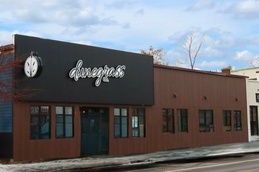
Restoring Sleeping Bear Inn
After sitting dormant for 50 years, the historic inn is poised to welcome visitors this summer
By Al Parker | May 4, 2024
It won’t be long before Glen Haven visitors will be able to experience waking up in the oldest hotel in the National Park Service.
For the past couple of months, room reservations have been taken almost daily for the fully refurbished Sleeping Bear Inn, which last hosted guests some 50 years ago.
“It’s been a labor of love,” says Maggie Kato, executive director of the nonprofit Balancing Environment and Rehabilitation (BEAR), which has a 40-year lease to rehab the inn and operate it as a bed and breakfast. “We are so very grateful for the support and assistance from everyone who helped us breathe life back into this historic treasure.”
More than 100 reservations, starting in August and running up to Christmas, have been booked at the eight-room inn. “Almost all of the weekends are gone,” says Kato. “For 15 weekends, all eight rooms are already booked.”
Scheming & Dreaming
Kato, her husband Jeff Kato, and construction manager George MacEachern have been the driving forces behind this years-long restoration project, which started as a dream back in 2018.
The Katos were living in Flint when Maggie read an article about how to be an innkeeper. Soon they were kicking around the idea of operating their own bed and breakfast. “We were scheming and dreaming together,” she says with a laugh.
The Katos were regular visitors to northern Michigan and followed up their talks by making a phone call to the park office to discuss the inn. After negotiations and lots of governmental paperwork, in January 2020, the Katos got a contract with the park service. The deal also includes a garage near the inn. Then COVID came along and the project stalled. Eventually, a lease was signed in March 2022.
The renovation is a $2 million project. The Katos sold their home, putting up $350,000 and receiving another $100,000 in gifts and donations. The balance is expected to come from room revenues.
On a blustery spring morning, an open house attracted hundreds of supporters and interested onlookers as Maggie and Jeff were handed inn keys by National Lakeshore superintendent Scott Tucker. “Cars were lined up all down the road,” says Maggie.
“The National Park Service is excited to see the Sleeping Bear Inn come back to life,” says Tucker. “One can imagine sitting on the porch in the late 1800s and reading a newspaper or watching the hustle and bustle around the frontier hotel. This summer, visitors are once again going to be able to experience walking up on the shore of Lake Michigan in the oldest hotel in the National Park Service.”
He goes on to add, “The park is proud of the work BEAR has done over the last 24 months to bring this moment in history back to the community, and I look forward to many years of collaboration and storytelling in Glen Haven.”
Restoring & Upgrading
The physical restoration work at the inn began immediately when MacEachern, a friend from Genesee County, moved to Leelanau County and brought his years of construction experience to the team.
There were decades of debris to clean out and plenty of repairs to make on the historic building. Painting, sanding, and revisions have been ongoing. “I learned a lot about [window] glazing,” jokes Maggie.
But the aged inn’s bones were good, including dozens of sturdy wooden beams, some up to 40 feet long. “The beams are beautiful,” says MacEachern, pointing out where someone carved initials into one of the solid venerable columns.
“We’ve had lots of help,” notes Jeff. “Close to 100 bodies have been involved in helping. Some gave hundreds of hours [of their time], and some gave six or eight. We’ve appreciated every one of them.”
And during the work, volunteers have unearthed an array of aged artifacts. They found a nickel dated 1868, a penny from 1879, a clay pipe, and a number of old-time medicine bottles—including an Alka Seltzer container complete with unused tablets—from the early 1900s.
“We found old shipping containers from Marshall Fields,” says Maggie, referring to the landmark upscale department store in Chicago. “We also found two [dinner] plates that were intact and several that were in pieces, along with a butter knife with a bone handle, license plates, and inkwells that date back to the 1800s.”
The upgrade is compliant with the Americans with Disabilities Act, with available ramps and one residential room on the first floor. The room features two private entrances and a cozy covered porch which offers a stunning view of Lake Michigan.
A large kitchen, a parlor and two dining rooms are also on the ground floor. Seven guest rooms, each with their own private bathrooms, are on the second floor. Room rates range from $269 to $339, depending on the view.
For more information, visit sleepingbearinn.org.
A Side of History
There’s some confusion about the earliest days of the inn. Some sources date its founding as early as 1857, others point to 1866. Either way, it was one of the most popular stops for ships plying the waters of the Great Lakes.
For about 30 years, a cruise along Lake Michigan was a more pleasant way to travel than by rail or road. It was common for Chicago businessmen to leave their families in northern Michigan for summer vacations, joining them on Saturday mornings after an overnight trip from Illinois. Often they would stay at the inn. The return trip to Chicago would leave Sunday night. The fare was $5 each way.
Early French-Canadian immigrants William and Ezilda Farrant managed the hotel and farmed the area. “The inn has a chair that was donated from the Farrant family,” says Maggie.
David Henry Day arrived in Glen Haven in 1878, appointed as an agent for the Northern Transportation Company, whose steamships stopped in the village to load up on wood to fuel their boilers. Over the next 10 years, Day directed operations in Glen Haven and worked for Hannah Lay in Traverse City, overseeing the lumbering operations. By 1890, the DH Day Company was well established in Glen Haven as a lumbering operation, supplying cordwood and producing hardwood lumber from the sawmill.
For a while, Day lived in a room suite at the inn. “This historic corner room was home to DH Day,” Maggie tells us. “With stunning views of the lake and the village, this spacious room will offer a memorable stay.”
On Dec. 20, 1889, 36-year-old Day, and 19-year-old Eva Ezilda Farrant were married. Eva was the daughter of the Farrants, who managed the Inn from 1877 to 1883 and 1896 to 1907. She was a schoolteacher in the area for three years prior to their marriage. Day and Eva had nine children, with seven living to adulthood.
Trending

Michigan’s Marijuana Tax at Work
Cannabis has become a big business in northern Michigan, and local governments are putting tax dollars earned from dispensar… Read More >>
California Sober: Why People Are Switching from Alcohol to Weed
They call it “California sober.” Generally speaking, this term applies to folks who use marijuana but abstain f… Read More >>
The Legacy of Student Activism
“It’s a physical letter to your representative,” Alex Tank says when asked to define the word “prote… Read More >>


